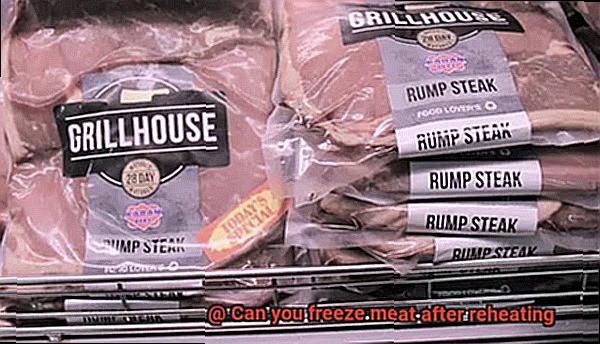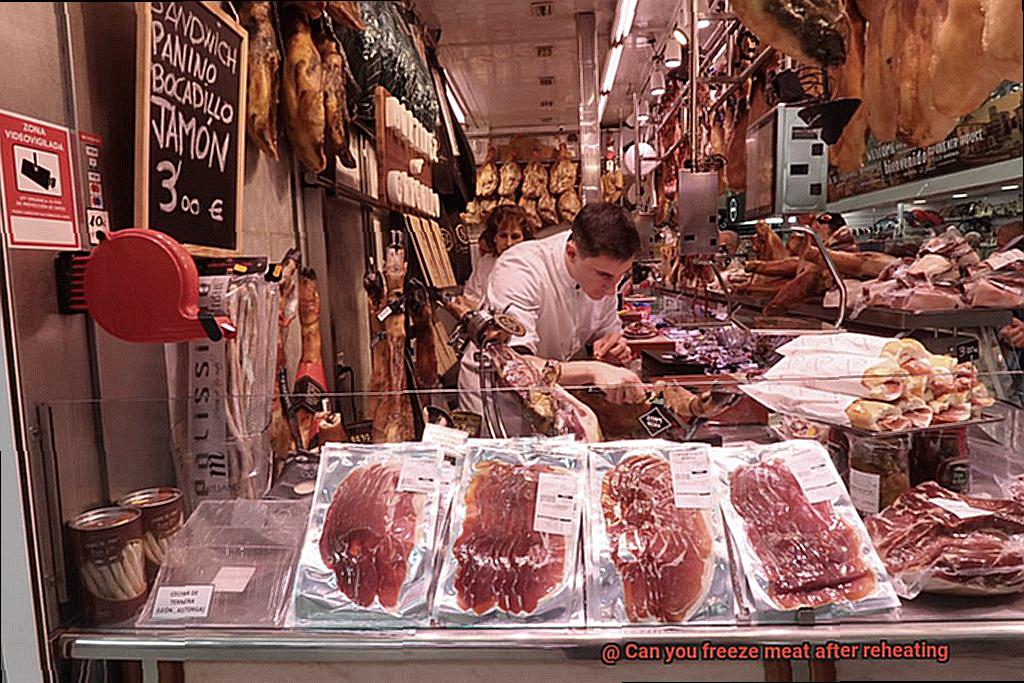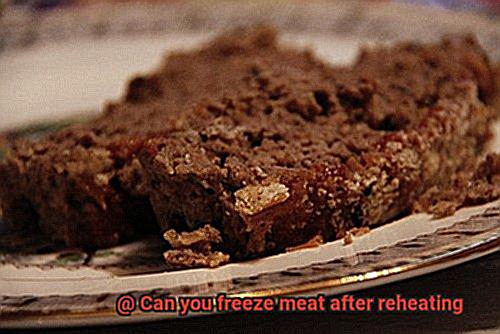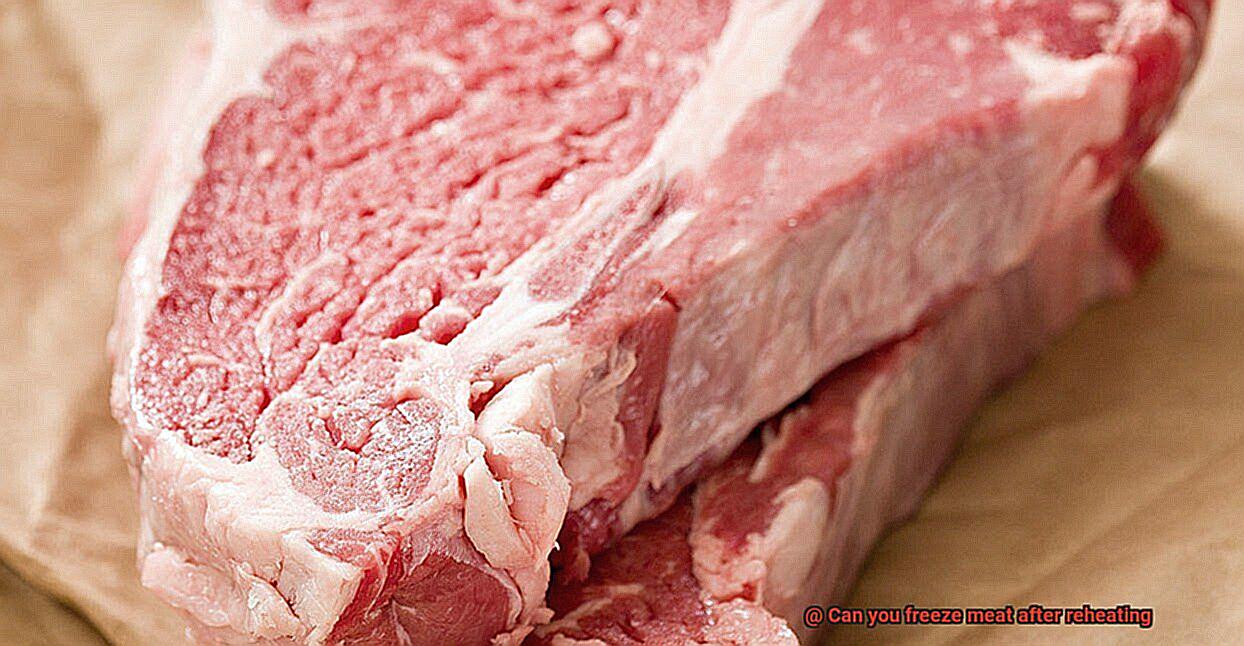Do you hate throwing away food and wasting money? Are you curious about whether or not you can freeze meat after reheating it? Well, the answer is simple, but many people are still confused.
Reheating meat is a common practice to save time and reduce food waste. However, it’s important to note that reheated meat may not be safe to consume later. Bacteria can grow rapidly in cooked meat left at room temperature for too long, which can lead to food poisoning.
Freezing meat is an excellent way to preserve it for future use and save money. But what about freezing meat after reheating it? Can you do that? The answer is yes, but there are some important things to consider.
In this blog post, we’ll take a closer look at the science behind freezing and reheating meat. We’ll also discuss the proper way to store, thaw, and reheat frozen meat so that it remains safe and delicious. Plus, we’ll share some handy tips and tricks for getting the most out of your leftovers. So if you’re ready to elevate your cooking game while being mindful of your wallet and reducing food waste, keep reading.
Contents
What is Reheating and Refreezing Meat?
Reheating and refreezing meat is a common practice in many households. However, it is crucial to follow proper food safety guidelines to avoid potential health risks. Reheating meat is the process of warming up pre-cooked meat to a safe temperature before consuming it. On the other hand, refreezing meat is the process of freezing previously frozen meat after thawing it out.
When not done correctly, reheating and refreezing meat can lead to bacterial growth, which can cause food poisoning. Therefore, it is essential to take appropriate measures to ensure that the meat remains safe and of good quality.
To ensure that reheated and refrozen meat remains safe and of good quality, it is important to follow proper food safety guidelines. Here are some tips to keep in mind:
- Reheat meat to a safe temperature: Bacterial growth can occur if cooked meat is not properly reheated. Use a food thermometer to check that the meat reaches an internal temperature of 165°F (74°C) before consuming.
- Cool meat quickly before freezing: If you have leftover cooked meat that you want to freeze for later use, cool it quickly in the refrigerator before placing it in the freezer. This will help prevent bacterial growth and ensure that the meat remains safe and of good quality.
- Refreeze immediately after thawing: When refreezing meat, it should be done immediately after thawing and should not be kept at room temperature for more than two hours. This will help prevent the growth of harmful bacteria and ensure that the meat remains safe to eat.
- Be aware of quality changes: Each time meat is reheated and refrozen, its quality may be affected. The texture and flavor may change slightly, and some meats may not freeze well after being cooked, such as deli meats or thinly sliced meats.
Is It Safe to Freeze Meat After Reheating?
Well, let me give you the inside scoop on all things reheating and freezing.
Reheating meat is generally safe as long as it’s done correctly. However, when it comes to freezing meat after reheating, there are a few crucial things to keep in mind.
Firstly, it’s important to ensure that the meat has been heated to an internal temperature of at least 165 degrees Fahrenheit before freezing. Doing so will kill any bacteria that might be present and make sure that the meat is safe for consumption after thawing.
Moreover, the length of time that the meat has spent sitting out at room temperature is another significant factor. If the meat has been at room temperature for more than two hours, do not freeze it as this increases the risk of bacterial growth.
It’s also worth noting that reheating can cause the meat to lose moisture, becoming dry and tough. Freezing the meat after reheating can further exacerbate this issue, which could result in less flavorful and tender meat.
Here are some tips to keep in mind when reheating and freezing your meats:
- Always ensure that your meat has been heated to the correct internal temperature before freezing.
- Do not freeze meat that has been sitting out at room temperature for more than two hours.
- Be aware that reheating and freezing can impact the quality of your meat, making it less tender and flavorful.
How to Safely Reheat and Refreeze Meat
Reheating and refreezing meat can be a lifesaver for busy people who don’t have time to cook every day. However, it’s important to remember that improper handling of meat can lead to foodborne illness. Here are some safety precautions that need to be taken when reheating and refreezing meat.
Thawing Meat
The first step in safely reheating meat is to thaw it properly. Never thaw meat at room temperature as this can cause harmful bacteria to grow. Instead, thaw meat in the refrigerator or in cold water. If using cold water, change the water every 30 minutes until the meat is fully thawed.
Reheating Meat
Once the meat is thawed, it can be reheated using a variety of methods such as microwaving, stovetop, or oven. It’s crucial to ensure that the meat reaches an internal temperature of at least 165°F to kill any harmful bacteria that may have grown during storage or thawing. Use a food thermometer to check the temperature in the thickest part of the meat.
Microwaves and slow cookers may not heat food evenly, so be sure to stir or rotate the meat during the cooking process. Once fully reheated, you can enjoy the meat immediately or store it in the refrigerator for up to four days.
Refreezing Meat
If there are any leftovers after reheating, it is possible to refreeze them. However, it’s important to follow some guidelines to ensure safety. The leftovers should be cooled down quickly and placed in a freezer within two hours of reheating. Additionally, it’s important to label the package with the date of freezing and use it within three months.
It’s worth noting that while it is possible to refreeze leftovers after reheating, it is not recommended to refreeze raw meat that has been previously frozen and thawed. This is because the process of freezing and thawing can cause changes in texture and quality that may affect its safety and taste.
Proper Storage
It’s important to store meat properly to avoid bacterial growth and foodborne illness. Use airtight containers or freezer-safe bags and remove as much air as possible before sealing. Label the package with the date of freezing, and consider using a vacuum sealer for optimal preservation.
It’s also essential to remember that each time meat is thawed and refrozen, its quality may deteriorate. Refreeze meat that has been thawed in the refrigerator and has not been left out at room temperature for more than two hours.
The Risks of Reheating and Refreezing Meat
You might want to think twice before doing so. As an expert on food safety, I can tell you that these practices can pose some serious health risks if not done properly. Let’s take a closer look at some of the potential dangers, so you can avoid any unpleasant consequences.
Reheating meat is a common practice, but did you know that it provides an ideal environment for bacteria to multiply? This means that if there were any bacteria present in the meat before, they now have a chance to grow and spread. The result? Food poisoning, if the meat isn’t heated to the proper temperature. And if you don’t consume the reheated meat right away, it should be cooled down as quickly as possible and stored in the refrigerator.
But it’s not just reheating that can be a problem – refreezing meat after it has already been thawed and reheated is also a big no-no. This is because freezing causes ice crystals to form within the tissue, which can damage the cell structure. When the meat is thawed, these ice crystals melt and leave behind moisture that can promote bacterial growth. Refreezing meat after it has been thawed and reheated can cause these bacteria to multiply even further, making it even more dangerous to consume.
To avoid these risks, it’s crucial to only thaw the amount of meat that will be needed for a meal. If there are leftovers, they should be cooled down as quickly as possible and stored in the refrigerator. It’s also important to make sure that any reheated meat is heated to the proper temperature (typically 165°F or 74°C) before consuming.

In summary, reheating and refreezing meat can be risky if not done properly. To ensure the safety of your food, always follow proper food handling and storage procedures. Here are some additional tips:

- Thaw meat in the refrigerator, not on the counter.
- Use a food thermometer to check that meat has been cooked to the appropriate temperature.
- Don’t leave meat out at room temperature for more than 2 hours.
- When in doubt, throw it out.

The Quality of the Meat After Reheating and Refreezing
It is a topic that causes concern for many people, and understandably so. Mishandling meat can lead to food poisoning, putting one’s health and that of their loved ones at risk.
Several factors can affect the quality of meat after being reheated and refrozen. These include how it was cooked, stored, and reheated. When meat is reheated, it loses some of its moisture content, making it tougher and less flavorful. This is especially true if the meat was overcooked initially. Furthermore, reheating meat can cause bacteria to multiply rapidly, which can lead to foodborne illnesses.
If meat has been frozen and then thawed before being reheated, the quality can suffer even more. During the freezing process, ice crystals form within the meat which damage the cell structure and make it more susceptible to drying out when cooked. Thawing and refreezing can also exacerbate this damage, resulting in a loss of texture and flavor.
To ensure optimal quality and safety, it is best only to reheat meat once and consume it immediately afterward. Leftovers should be refrigerated and consumed within a few days or frozen for later use. Freezing meat after it has been reheated is not recommended since it can compromise both quality and safety.
Proper food handling procedures should always be followed when reheating and refreezing meat. This includes cooking meat to the appropriate temperature, cooling leftovers quickly, and only thawing what is needed. By doing so, you’ll ensure that your meat is safe to eat and tastes great too.

Different Types of Meats That Can Be Frozen After Reheating
You can freeze meats after reheating them. However, not all meats freeze well. Here are five types of meats that can be safely frozen after reheating:
Beef

Whether it’s a juicy steak or a tender roast, beef is a popular meat to freeze after reheating. It holds up well and maintains its flavor and texture. However, keep in mind that leaner cuts of beef may dry out more easily when frozen and reheated.
Chicken
Chicken is an easy and versatile meat to freeze after reheating. It retains its flavor and texture well, but it’s important to make sure it’s cooked thoroughly before freezing to prevent any foodborne illnesses.
Pork
From ribs to chops, pork can also be frozen after reheating. However, it may lose some of its tenderness and flavor. To prevent this, cook pork to the proper temperature before freezing.
Fish
Fish is a delicate protein that requires special care when freezing and reheating. Freezing fish immediately after cooking can help preserve its quality, but keep in mind that it may become dry and lose some of its flavor and texture.
Ground Meat
Ground meat, such as beef or turkey, is a staple in many households. It can be safely frozen after reheating, but make sure to cook it thoroughly before freezing and wrap it tightly in plastic wrap or aluminum foil to prevent freezer burn.
When considering which meats to freeze after reheating, take into account their texture and flavor as well as how they will hold up during the freezing and reheating process. Remember that each time meat is reheated and refrozen, its quality may be affected. Always reheat meat to a safe temperature (165°F for poultry) and cool it quickly before freezing.
Tips for Freezing Cooked Meat
Freezing it is a great way to preserve the leftovers and prevent food waste. However, you need to know how to freeze cooked meat properly to ensure it stays fresh and safe. Here are some tips for freezing cooked meat that will help you do it like a pro.
Cool the Meat Before Freezing
One of the most important things when freezing cooked meat is to ensure it has cooled down completely. This will prevent bacteria growth and avoid freezer burn. You can cool the meat by placing it in the fridge for a few hours or by placing it in an ice bath.
Use Freezer-Safe Containers
Another crucial aspect of freezing cooked meat is using containers that are designed for freezer use. These containers can withstand low temperatures and prevent freezer burn from happening, preserving the flavor and texture of the meat.
Label and Date the Containers
Before putting your cooked meat in the freezer, label and date the containers. This will help you keep track of what’s in your freezer and how long it’s been there. You can use labels or a permanent marker to mark the containers.
Freeze in Small Portions
Freezing cooked meat in small portions makes it easier to thaw and use later on. You can freeze portions in individual containers or in freezer bags, depending on what works best for you.
Use Within 3-4 Months
Cooked meat should be consumed within 3-4 months of freezing. After this time, its quality may start to deteriorate, and it may no longer be safe to eat.
h6nXw8DFCQA” >
Conclusion
In conclusion, reheating and refreezing meat can be a lifesaver when it comes to saving time and reducing food waste. However, it’s crucial to follow proper food safety guidelines to avoid potential health risks. Reheating meat is generally safe if done correctly, but freezing it after reheating requires extra caution.
To ensure that reheated and refrozen meat remains safe and delicious, it’s essential to follow proper food safety guidelines. Make sure the meat reaches an internal temperature of at least 165 degrees Fahrenheit before freezing. Additionally, how long the meat sits out at room temperature is a critical factor.
It’s worth noting that reheating can cause the meat to lose moisture, resulting in dry and tough texture. Freezing the meat after reheating can make this problem even worse, leading to less flavorful and tender meat.
To safely reheat and refreeze meat, you should thaw it properly, cook it thoroughly before freezing or refreezing, cool leftovers quickly, store them in freezer-safe containers or bags with labels indicating the date of freezing, use within three to four months of freezing or discard if quality deteriorates.






